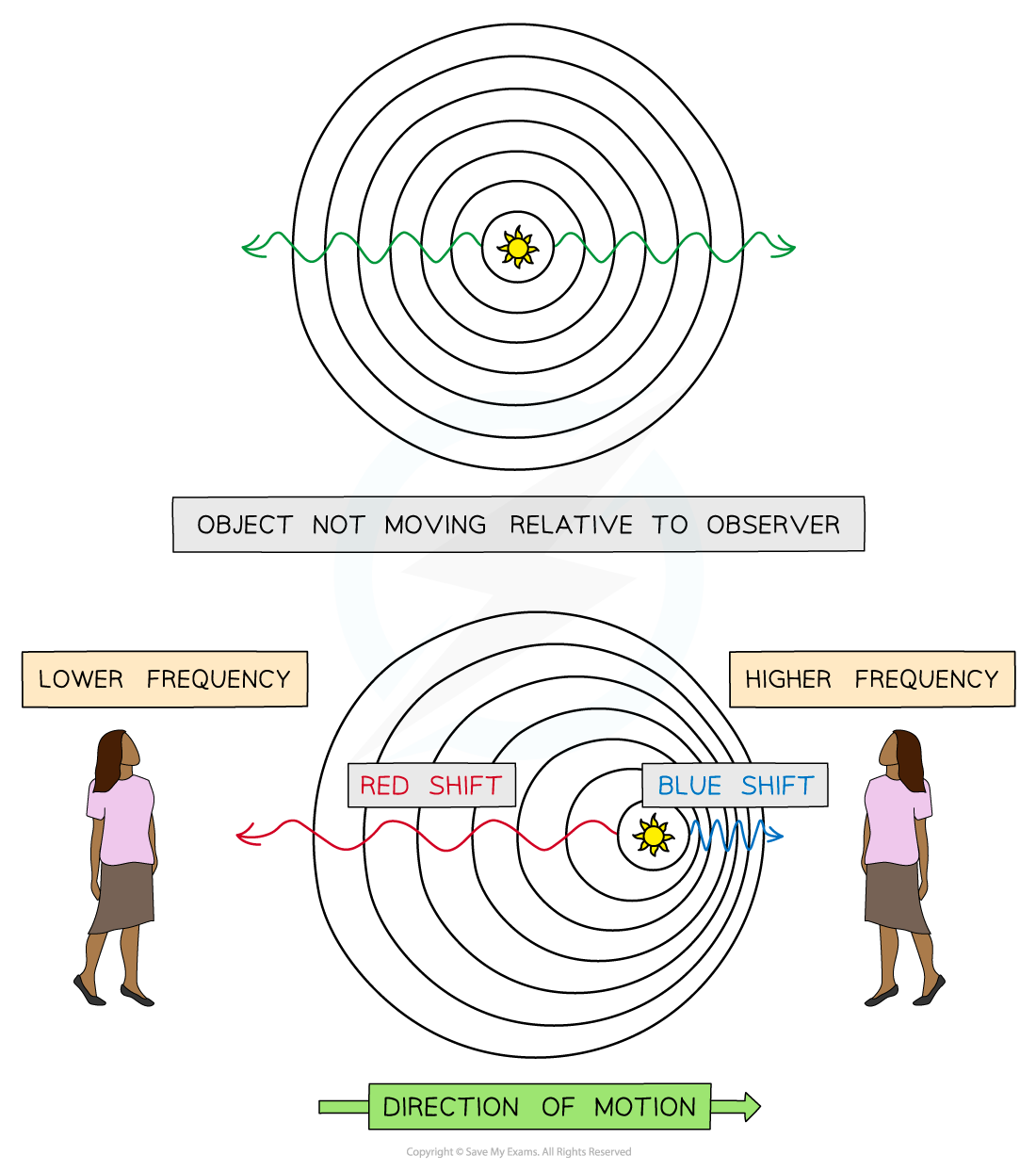The Doppler Effect of Light (AQA A Level Physics): Revision Note
Exam code: 7408
The Doppler Effect of Light
The Doppler shift for a light-emitting non-relativistic (v << c) source can be described using the equation:
Where:
= change in frequency (Hz)
= reference frequency (frequency of the source) (Hz)
= change in wavelength (m)
= reference wavelength (wavelength of the source) (m)
= relative velocity of the source and observer (m s–1)
= the speed of light (m s–1)
The change in wavelength
is equal to:
Where:
= observed wavelength of the source (m)
The relative speed between the source and observer along the line joining them is given by:
Where:
= velocity of the light source (m s–1)
= velocity of the observer (m s–1)
The velocity of the observer (usually from Earth) can be assumed to be stationary, i.e.
The relative speed then simply becomes the speed of the source:
Hence, the Doppler shift equation can be written as:
Redshift
The fractional change in the wavelength
is called the redshift and is given the symbol
In terms of wavelength, redshift is given by:
In terms of frequency, redshift is given by:
This shows that if the source moves away from the observer then
The wavelength increases
The frequency decreases
Note: the sign of z can cause some confusion, remember to look at the context - z is a measure of redshift so write it as positive for receding objects
Doppler Shift of Light

Doppler shift can be observed in the spectra of stars and galaxies
If the star is approaching the Earth, blueshift is observed (negative
)
The relative velocity
is positive
The change in wavelength
is negative
If the star is receding from the Earth, redshift is observed (positive
)
The relative velocity
is negative
The change in wavelength
is positive
Worked Example
A stationary source of light is found to have a spectral line of wavelength 438 nm. The same line from a distant star that is moving away from the Earth has a wavelength of 608 nm.
Calculate the speed at which the star is travelling away from the Earth.
Answer:
Step 1: List the known quantities
Unshifted wavelength, λ = 438 nm
Shifted wavelength, λ' = 608 nm
Change in wavelength, Δλ = (608 – 438) nm = 170 nm
Speed of light, c = 3.0 × 108 m s–1
Step 2: Write down the Doppler equation and rearrange for velocity v
Step 3: Substitute values to calculate v
= 1.16 × 108 m s–1
Worked Example
The stars in a distant galaxy can be seen to orbit about a galactic centre. The galaxy can be observed 'edge-on' from the Earth.
Light emitted from a star on the left-hand side of the galaxy is measured to have a wavelength of 656.44 nm. The same spectral line from a star on the right-hand side is measured to have a wavelength of 656.12 nm.
The wavelength of the same spectral line measured on Earth is 656.28 nm.
(a) State and explain which side of the galaxy is moving towards the Earth.
(b) Calculate the rotational speed of the galaxy.
Answer:
Part (a)
The light from the right-hand side (656.12 nm) is observed to be at a shorter wavelength than the reference line (656.28 nm)
Therefore, the right-hand side shows blueshift and must, therefore, be moving towards the Earth
Part (b)
Step 1: List the known quantities
Observed wavelength on LHS,
= 656.44 nm
Observed wavelength on RHS,
= 656.12 nm
Reference wavelength, λ = 656.28 nm
Speed of light, c = 3.0 × 108 m s−1
Step 2: Calculate the average change in wavelength
The magnitude of redshift or blueshift from each side is different, so you must calculate the average
= 0.16 nm
Tip: you don't need to change the wavelengths from nm to m, as the units will cancel out later
Step 3: Write down the Doppler equation and rearrange for velocity v
Step 4: Substitute values into the velocity equation
Rotational speed:
Examiner Tips and Tricks
You need to recall that, in the visible light spectrum, red light has a longer wavelength and a lower frequency compared to blue light which has a shorter wavelength and a higher frequency

Unlock more, it's free!
Did this page help you?